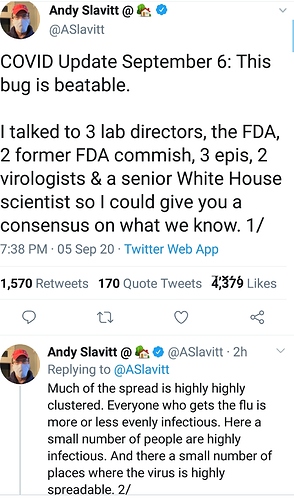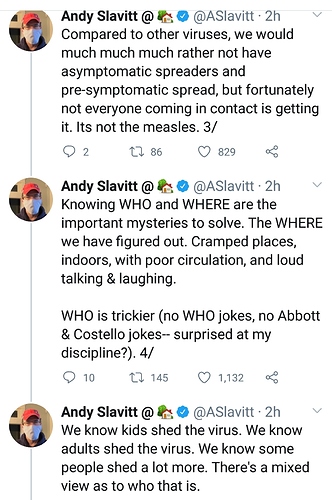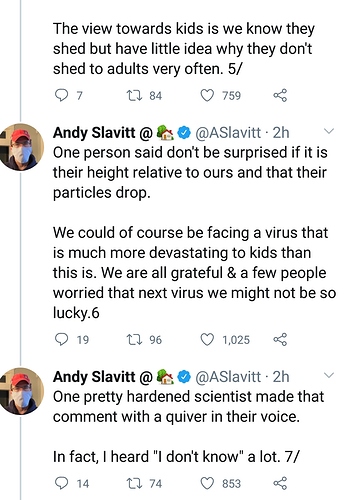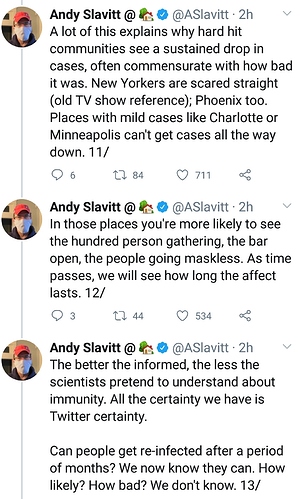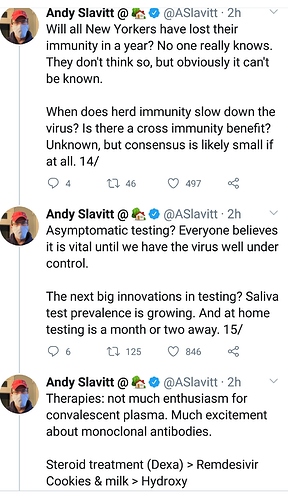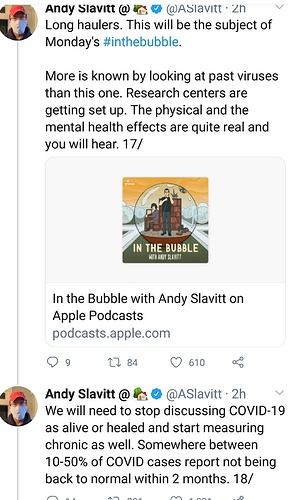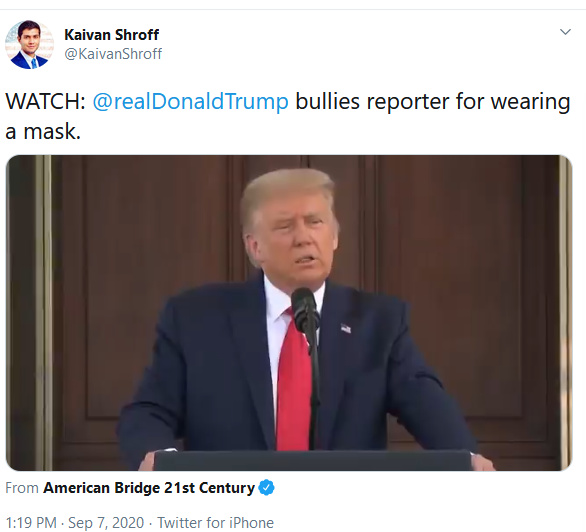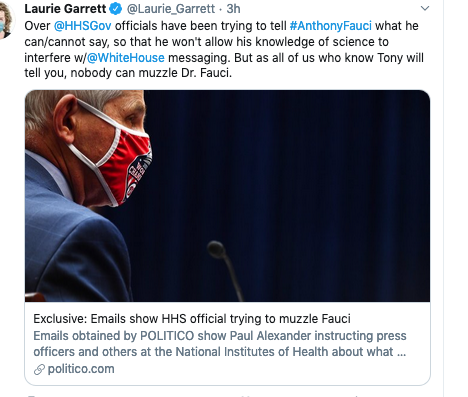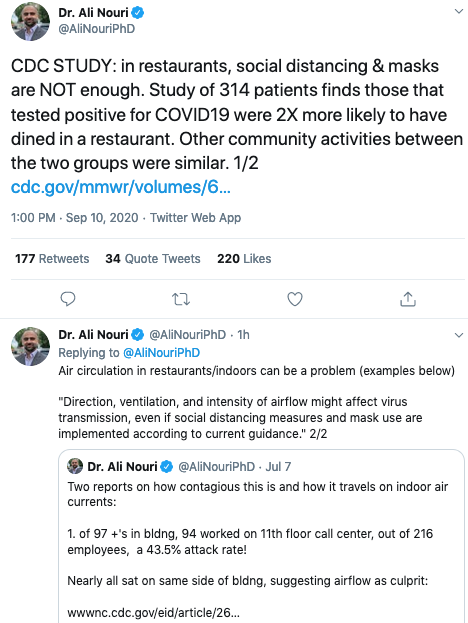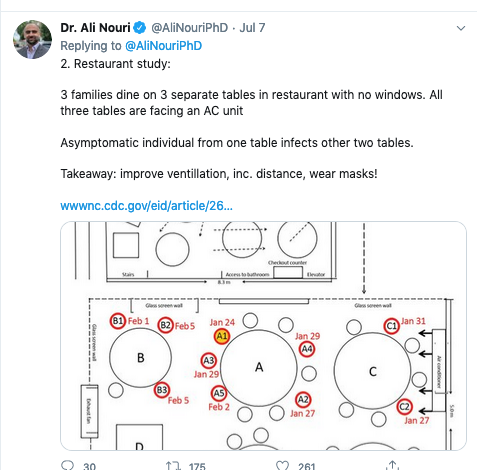Lots of good insights here on Covid19
Sturgis Motorcycle Rally Is Now Linked to More Than 250,000 Coronavirus Cases
One study estimates the public health cost of the super-spreading event is near $12 billion.
Researchers Say Fresh Air Can Prevent Aerosol Transmission Of The Coronavirus
On the vaccine front - a stop placed on the AstroZeneca trial. It is in Phase 3.
A large, Phase 3 study testing a Covid-19 vaccine being developed by AstraZeneca and the University of Oxford at dozens of sites across the U.S. has been put on hold due to a suspected serious adverse reaction in a participant in the United Kingdom.
A spokesperson for AstraZeneca, a front-runner in the race for a Covid-19 vaccine, said in a statement that the company’s “standard review process triggered a pause to vaccination to allow review of safety data.”
It was not immediately clear who placed the hold on the trial, though it is possible it was placed voluntarily by AstraZeneca and not ordered by any regulatory agency. The nature of the adverse reaction and when it happened were also not immediately known, though the participant is expected to recover, according to an individual familiar with the matter.
The spokesperson described the pause as “a routine action which has to happen whenever there is a potentially unexplained illness in one of the trials, while it is investigated, ensuring we maintain the integrity of the trials.” The spokesperson also said that the company is “working to expedite the review of the single event to minimize any potential impact on the trial timeline.”
An individual familiar with the development said researchers had been told the hold was placed on the trial out of “an abundance of caution.” A second individual familiar with the matter, who also spoke on condition of anonymity, said the finding is having an impact on other AstraZeneca vaccine trials underway — as well as on the clinical trials being conducted by other vaccine manufacturers.
I am actually okay with this. This is not a sad thing. Like, it would suck if they had to pull it altogether, but it means that they are taking care and doing it right instead of cramming it out the door anyway because money or politics or whatever.
‘Play it down’: Trump admits to concealing the true threat of coronavirus in new Woodward book
Woodward book: Trump says he knew coronavirus was ‘deadly’ and worse than the flu while intentionally misleading Americans
Trump admitted downplaying coronavirus dangers in early days of pandemic, new Bob Woodward book says
The CNN one has recordings. It’s devastating.
From the WaPo article, it’s so bad.
Matthew Pottinger, the deputy national security adviser, agreed. He told the president that after reaching contacts in China, it was evident that the world faced a health emergency on par with the flu pandemic of 1918, which killed an estimated 50 million people worldwide.
Ten days later, Trump called Woodward and revealed that he thought the situation was far more dire than what he had been saying publicly.
“You just breathe the air and that’s how it’s passed,” Trump said in a Feb. 7 call. “And so that’s a very tricky one. That’s a very delicate one. It’s also more deadly than even your strenuous flu.”
“This is deadly stuff,” the president repeated for emphasis.
At that time, Trump was telling the nation that the virus was no worse than a seasonal flu, predicting it would soon disappear, and insisting that the U.S. government had it totally under control. It would be several weeks before he would publicly acknowledge that the virus was no ordinary flu and that it could be transmitted through the air.
70 days: The U.S. was beset by denial and dysfunction as the coronavirus raged
Trump admitted to Woodward on March 19 that he deliberately minimized the danger. “I wanted to always play it down,” the president said.
Aside from exploring Trump’s handling of the pandemic, Woodward’s new book, “Rage,”covers race relations, diplomacy with North Korea and a range of other issues that have arisen during the past two years.
The book also includes brutal assessments of Trump’s conduct from former defense secretary Jim Mattis, former director of national intelligence Daniel Coats and others.
The book is based in part on 18 on-the-record interviews Woodward conducted with the president between December and July. Woodward writes that other quotes in the book were acquired through “deep background” conversations with sources in which information is divulged and exchanges recounted without sources being named.
Stay safe and informed with our free Coronavirus Updates newsletter
“Trump never did seem willing to fully mobilize the federal government and continually seemed to push problems off on the states,” Woodward writes. “There was no real management theory of the case or how to organize a massive enterprise to deal with one of the most complex emergencies the United States had ever faced.”
It’s not the Buck Stops Here kind of response…
#Satire from The Borowitz Report
Trump Plans to Destroy Coronavirus with an Incredibly Mean Tweet
WASHINGTON (The Borowitz Report)—Donald Trump said on Wednesday that he was planning to destroy the coronavirus by sending an “incredibly mean tweet” in its direction.
Speaking to reporters at the White House, Trump said that he was already in the process of crafting insults about the virus that would obliterate it once and for all.
In a preview of the mean tweet he is devising, Trump said, “The thing about the virus is it’s incredibly small. It’s smaller than Mike Bloomberg. Once I point that out, the coronavirus won’t know what hit it.”
He added that he was also in the process of coming up with an insulting nickname for the virus.
“It’s going to be something about how small it is,” Trump said. “Something like Lil’ Micro Mini Virus. I’m still working on it, but it’s going to be so mean. You won’t believe how mean it’s going to be.”
Trump was dismissive of the scientists who have raised dire concerns about the virus in recent days. “These so-called experts are the same people who said I needed sunglasses to stare at the eclipse,” he said.
Here is the audio-transcript video.
Here is the February call:
Whoa.
I collected the four audio clips from the Woodward CNN story. Here they are in both video and audio format, and a CNN version of a couple of them:
https://drive.google.com/file/d/1FQBMXm8UnIPqsYpuPmXZxmP3biZ4tlSm/view?usp=sharing
More revelations about how much the WH wanted to muzzle Dr. Fauci…minimize the dangers of Covid-19.
Emails obtained by POLITICO show Paul Alexander — a senior adviser to Michael Caputo, HHS’s assistant secretary for public affairs — instructing press officers and others at the National Institutes of Health about what Fauci should say during media interviews. The Trump adviser weighed in on Fauci’s planned responses to outlets including Bloomberg News, BuzzFeed, Huffington Post and the science journal Cell.
Alexander’s lengthy messages, some sent as recently as this week, are couched as scientific arguments. But they often contradict mainstream science while promoting political positions taken by the Trump administration on hot-button issues ranging from the use of convalescent plasma to school reopening.
The emails add to evidence that the White House, and Trump appointees within HHS, are pushing health agencies to promote a political message instead of a scientific one.
“I continue to have an issue with kids getting tested and repeatedly and even university students in a widespread manner…and I disagree with Dr. Fauci on this. Vehemently,” Alexander wrote in one Aug. 27 email, responding to a press-office summary of what Fauci intended to tell a Bloomberg reporter.
And on Tuesday, Alexander told Fauci’s press team that the scientist should not promote mask-wearing by children during an MSNBC interview.
“Can you ensure Dr. Fauci indicates masks are for the teachers in schools. Not for children,” Alexander wrote. “There is no data, none, zero, across the entire world, that shows children especially young children, spread this virus to other children, or to adults or to their teachers. None. And if it did occur, the risk is essentially zero,” he continued — adding without evidence that children take influenza home, but not the coronavirus.
In a statement attributed to Caputo, HHS said that Fauci is an important voice during the pandemic and that Alexander specializes in analyzing the work of other scientists.
“Dr. Alexander advises me on pandemic policy and he has been encouraged to share his opinions with other scientists,” Caputo said. “Like all scientists, his advice is heard and taken or rejected by his peers. I hired Dr. Alexander for his expertise and not to simply resonate others’ opinions.”
Neither Alexander nor NIH spokespeople responded to requests for comment.
And here’s Dr. Fauci’s real viewpoint about what he thinks about T.
Fauci Says Trump’s Attention Span Is a ‘Minus Number,’ Only Cares About Getting Re-elected: Woodward Book
The infectious diseases expert told others that Trump “is on a separate channel” and called his leadership "rudderless."
Hard to really see if that Sturgis Motorcycle Rally was indeed a superspreader. That study was done by economists, and it accounted for the potential hospitalization costs. Yet, so far
only 1 death, and 260 cases showing up in 11 states. It happened Aug 7th - 16th…so there probably will be more.
Based on the increase in case count, the researchers group, estimated that cases connected to the gathering resulted in $12 billion in public health costs, not including the costs associated with any deaths that might be tied to cases from the event. That dollar amount is based on another estimation that an average of $46,000 is spent on each patient who tests positive for COVID-19.
Researchers concluded that more than 266,000 cases were tied to the event attended by more than 460,000 individuals.
Health officials have linked at least one death to the rally: a male biker in his 60s with underlying conditions. At least 260 cases in 11 states have been officially connected to the rally by government officials.
The annual event ran from Aug. 7-16 and drew more than 365,00 vehicles, according to South Dakota’s Department of Transportation.
Now we’re all here together tonight. And we’re being human once again. Fck that COVID sht.”
As is taught in every introductory statistics class, there is a critical difference between correlation and causation. And the four authors of the study are economists, not epidemiologists.
But someone who is an epidemiologist, the highly regarded disease specialist Dr. Jeffrey Klausner, described the results of the study as “plausible” in an interview with The Daily Beast. Prominent virologist Dr. Angela Rasmussen used the very same word in describing the study to The Beast. Both Klausner and Rasmussen noted the size of the rally and the crowd’s apparent failure to take mitigating precautions.
Klausner did take issue with the study’s estimate that the additional cases generated public health costs of $12.2 billion. He termed the number “absurd,” observing that it was generated by what the study terms that “the statistical cost of COVID-19 case of $46,000.” Klausner figures that a fair number of those who tested positive would have been either asymptomatic or in need of only minimal medical care.
Part of the review will include generating a timeline of the participant’s symptoms to see if they match up roughly with when the vaccine was administered. The committee will also investigate other potential causes of the symptoms, in a process of elimination.
After determining whether AstraZeneca’s vaccine is the probable cause, experts will advise the company on whether to resume its trials.
Regulatory agencies like the Food and Drug Administration will also likely collect data and give additional input along the way, said Dr. Mark Goldberger, an infectious disease expert at the Global Antibiotic Research and Development Partnership and a former F.D.A. official.
No further doses of the vaccine will be administered in the interim.
A hearing on Capitol Hill yesterday with NIH Director and updates on the vaccines.
Can you put under Coronavirus please? @anon95374541 @MissJava Thanks!
N.I.H. Director Undercuts Trumpâs Comments on Covid-19 Vaccines - The New York Times
At the hearing, Democrats on the panel grilled both Dr. Collins and Surgeon General Jerome Adams on the effect of Mr. Trump’s false statements about the vaccine, and whether they would erode trust in the development process. Dr. Collins demurred, however, as Senator Elizabeth Warren, Democrat of Massachusetts, asked him point blank whether Mr. Trump’s misinformation would discourage people from taking the vaccine and hurt the effort to distribute it.
“I’m not sure I know the answer to that question,” Dr. Collins said. When Ms. Warren pressed him again, he added, “I just hope Americans will choose to take the information they need from scientists and not from politicians.”
Three companies are in late-stage, Phase 3 clinical trials that seek to enroll 30,000 Americans, half of whom will be injected with the vaccine candidate and half of whom will get a placebo.
Dr. Collins said he had “cautious optimism” that a safe and effective vaccine would emerge by the end of the year, though he added, “but even that is a guess.”
Even as the trials proceed, there are huge questions about who will get a vaccine first and how it will be distributed. Dr. Adams told the panel that the administration intended to release guidelines later Wednesday that would allow state-licensed pharmacists to vaccinate anyone older than age 3.
Coronavirus-related deaths of young teachers raise alarm as new school year begins
Teachers in at least three states have died after bouts with the coronavirus since the beginning of the new school year. The deaths have left a teachers’ union leader worrying that the return to in-person classes will have a deadly impact across the U.S. if proper precautions aren’t taken.
In Missouri, AshLee DeMarinis was just 34 when she died Sunday after three weeks in the hospital. She taught social skills and special education at John Evans Middle School in Potosi about 70 miles southwest of St. Louis.
“The kids absolutely adored her. She was a brilliant special ed teacher,” former coworker Mandy Blanks told CBS affiliate KMOV.
In South Carolina, officials with Richland School District 2 say 28-year-old Demi Bannister was diagnosed with the virus on Friday and died Monday. Bannister was a third grade teacher starting her fifth year of teaching at Windsor Elementary School in Columbia.
Officials say Bannister was at the school on Aug. 28, during a week of teacher workdays before the school year began.
Two other educators died recently in Mississippi. It’s unclear how many teachers in the U.S. have become ill with COVID-19 since the new school year began, but Mississippi alone has reported 604 cases among school teachers and staff.
The news comes amid grim new data about COVID-19 cases in children: More than 500,000 kids in the U.S. have tested positive for the coronavirus since the pandemic began. The American Academy of Pediatrics said children represented 9.8% of all COVID-19 cases in the U.S., where more than 6.3 million total cases have been reported, according to data compiled by Johns Hopkins University.
Randi Weingarten, president of the American Federation of Teachers, said schools need guidelines such as mandatory face coverings and strict social distancing rules to reopen safely.
“If community spread is too high as it is in Missouri and Mississippi, if you don’t have the infrastructure of testing, and if you don’t have the safeguards that prevent the spread of viruses in the school, we believe that you cannot reopen in person,” Weingarten said.
Johnny Dunlap, a 39-year-old drama and forensics teacher at Dodge City High School in Kansas, said he considered quitting before the district made masks mandatory for teachers and students. Still, his history of bladder cancer and high blood pressure have left him with some angst about being around so many people. Existing health conditions can put people at higher risk for severe illness and death from the virus.
“I’m at a high school with close to 2,000 students so it kind of runs against the advice we have been given for half a year now,” Dunlap said.
The early phase of the pandemic claimed the lives of dozens of teachers. The New York City Department of Education alone lost 31 teachers among 75 employees whose deaths were blamed on the coronavirus.
Across the U.S., the American Federation of Teachers lists 210 union members who have died. The list includes support staff and retirees as well as teachers.
The start of the new school year brought with it new fatalities.
In Oxford, Mississippi, 42-year-old Nacoma James taught at a middle school and helped coach high school football. He died Aug. 6 during the first week of classes, but was self-quarantining when teachers and students returned to the classroom, said Lafayette County School District Superintendent Adam Pugh.
Pugh recalled that James was a seventh-grade student when he began teaching 30 years ago.
“It was a hard punch to my stomach, when I heard,” Pugh said.
James worked with football players during summer workouts, but an investigation found no new cases linked to him, Pugh said.
Another Mississippi teacher died Sunday. History teacher Tom Slade recently posted on Facebook about his battle with pneumonia caused by the coronavirus. On Tuesday the American flag in front of Vancleave High School was flying at half staff, CBS affiliate WLOX reported.
Slade was teaching in-person when the academic year started on Aug. 6, Principal Raina Holmes said, but began quarantining after he had contact with someone who was positive at a church meeting. His last day of teaching was Aug. 21.
Slade was known for jokingly using a judge’s gavel to quiet noisy students.
“He always brought humor into his classroom and his students loved that part about him,” said Holmes.
In Potosi, in-person classes started Aug. 24. DeMarinis was already hospitalized by then but had been in the school preparing for the year a couple of weeks earlier, her sister, Jennifer Heissenbuttel said.
Superintendent Alex McCaul said contact tracing determined she had no close contact with any teachers, students or staff.
DeMarinis grew up near New York but developed a passion for her rural school and Potosi, a town of 2,600 residents, Heissenbuttel said.
DeMarinis had wanted to teach special education since she was a child, when a special education teacher helped her overcome mild dyslexia.
“She had the patience of a saint. She was really meant for it,” Heissenbuttel said. “The kids loved her. She touched so many lives.”
DeMarinis had asthma, which can put someone more at risk from severe illness from COVID-19. She began feeling poorly around mid-August, Heissenbuttel said. After developing fever and shortness of breath, she was tested for the coronavirus and was soon hospitalized.
It’s unclear where DeMarinis picked up the virus.
Heissenbuttel is a nurse who works in a New York area hospital’s intensive care unit. Somehow, she managed to avoid the illness that her sister couldn’t.
“I thought it would be me, not her,” Heissenbuttel said.
Summary
What is already known about the topic?
Community and close contact exposures contribute to the spread of COVID-19.
What is added by this report?
Findings from a case-control investigation of symptomatic outpatients from 11 U.S. health care facilities found that close contact with persons with known COVID-19 or going to locations that offer on-site eating and drinking options were associated with COVID-19 positivity. Adults with positive SARS-CoV-2 test results were approximately twice as likely to have reported dining at a restaurant than were those with negative SARS-CoV-2 test results.
What are the implications for public health practice?
Eating and drinking on-site at locations that offer such options might be important risk factors associated with SARS-CoV-2 infection. Efforts to reduce possible exposures where mask use and social distancing are difficult to maintain, such as when eating and drinking, should be considered to protect customers, employees, and communities.
Yeah, don’t take your mask off with people outside your household. Anyplace where people are crowded and talking a lot, that’s where a mask should be worn. Eat outside or at home to be safe.
Woodward Interviews Shallow Throat
The most damaging revelations about this president come not from shadowy bureaucrats but from the people closest to him.
For years, President Donald Trump and his allies have warned about his adversaries in the “Deep State.” The phrase evokes images of anonymous officials with hidden motives buried deep in the government.
Recent days have made it clearer than ever that the real hazard to Trump is actually the Shallow State.
The people saying mean things about Trump aren’t lurking in the shadows. They are well-known names whom Trump recruited to work by his side. Their motives aren’t mysterious. They are obvious: A transactional president encourages transactional behavior in his midst. These sources have shocking stories to tell, but no longer any genuinely surprising ones.
The plot is playing out now in familiar ways. Prominent people typically went to work for Trump thinking he seems like a jerk but, hey, he was elected, after all. So they calculated that maybe he’s not so bad and that the compensations in power and status of an important job were worth the trade. They believed the Republic would be better off with their wise counsel helping curb Trump’s worst instincts. Once there, they discovered that the president is more self-absorbed and less tethered to public interest than they had previously imagined. Having been lured into the inner circle to enhance their reputations, they fear—often with good reason—that they are leaving soiled by Trump’s splatter.
So they write books, like former Trump lawyer-fixer Michael Cohen. Or they talk to magazine journalists, like the senior military officers who told damaging tales to The Atlantic’s Jeffrey Goldberg or dispatched surrogates to do so. Above all, they sit with Washington’s legendary confessor priest, Bob Woodward, for his new book, “Rage.”
The entire notion of the Deep State rests on soil tilled by Hollywood, in decades of movies and television shows in the genre of the paranoid thriller. In these conspiracy dramas, the plot tension flows from a slowly building, creepy realization that Things Are Not What They Seem .
Woodward, based on Wednesday’s barrage of publicity for next week’s official release of “Rage,” has once again delivered the goods with plenty of news-driving revelations. But these scoops are like so many in the Trump years: They reveal that things are pretty much Exactly What They Seem .
It seemed last winter and spring that Trump was prattling on with a lot of happy talk that he couldn’t possibly believe about how the coronavirus wouldn’t be that serious—even as his own government officials were warning that it would be—because he was desperately trying to create reality by proclamation. Months later, Woodward has confirmed that to be true.
What’s more, his source was not a latter-day Deep Throat skulking around garages on behalf of the Deep State. The most damaging source for Woodward is on the record and on tape: Trump himself.
It had previously seemed that Trump, despite his constant attacks on the “Fake News” media, had a compulsive fascination with establishment media figures and the coverage they give him. Now the president has confirmed that to be true, giving 18 (!) interviews to Woodward. Think of him as Shallow Throat.
“Rage,” like The Atlantic piece, also includes material developed through the more conventional way that important people unload their feelings about Trump: On “deep background.” This is the same practice by which we have learned startling accounts about the decision-making and internal battles surrounding previous presidents.
Only this time, the revelations are much more sensational, much more about defects of presidential character than the behind-the-scenes dynamics of policy debates.
The revelations are also much more perishable.
This summer alone there have been a half-dozen—or more? What’s missing?—damning, all-consuming, now-it-can-be-told firestorms about Trump and his governing style, including revelations that would have been monthslong showstoppers in any previous presidency.
It may seem like a year ago, but former national security adviser John Bolton’s devastating book, “The Room Where It Happened,” came out in mid-June. August brought Mary L. Trump’s devastating book, “Too Much and Never Enough: How My Family Created the World’s Most Dangerous Man.” This month brought Goldberg’s devastating article, “Trump: Americans Who Died in War are ‘Losers’ and ‘Suckers.’” And also Michael Schmidt’s devastating book, “Donald Trump v. the United States: Inside the Struggle to Stop a President.” A couple days later brought Cohen’s devastating book, “Disloyal,” which includes allegations of racially bigoted remarks and conniving with the National Enquirer . It is unclear how much publishing oxygen there will be for this or whether it will be sucked up by Woodward’s devastating “Rage.”
Some of the passages from Woodward promoted on Wednesday highlight the nature of the Shallow State’s dealings with Trump. It turns out former Defense Secretary James Mattis regards Trump as “dangerous” and “unfit,” with “no moral compass.” Former Director of National Intelligence Dan Coats allegedly agrees, and has “deep suspicions” that Russian President Vladimir Putin “had something” damaging on Trump since he saw “no other explanation” for some of Trump’s behavior.
Where does this come from? Possibly the Deep State has bugs in Mattis’ and Coats’ offices or computers, and figured out some way—no fingerprints—to get the material in Woodward’s hands. Or perhaps Mattis and/or Coats told Woodward things they thought and said on condition of “deep background.”
The first question in the spate of new books and articles in which people once in Trump’s orbit tell their stories is whether they are believable. In most cases, the news coverage, citing previous patterns in Trump’s behavior, tends to accept the anecdotes as credible. This raises a secondary question—less important but interesting—what do we think of the people who raise their voices to share critical information or character appraisals of their boss?
Should they be hailed as brave truthtellers? Or do their actions raise uncomfortable questions about their own values, no less than Trump’s?
As a journalist, I certainly have no interest in making censorious judgments about people’s reasons for speaking their truths. But there is no need to assign valorous motives to decisions that often seem to have more prosaic explanations: self-interest, vanity, revenge and so on.
In some cases, one suspects that loathing of Trump is merged with self-loathing for investing hope in Trump or ever believing that joining his circle on his terms would be a worthwhile transaction.
Mary Trump has offered valuable insights into what seems to be the president’s dysfunctional upbringing. But she also makes plain that she was wounded by family disputes over her grandfather’s will.
Jim Mattis joined the Trump administration at the beginning and can plausibly say he thought he was performing a patriotic duty. But John Bolton joined the White House as national security adviser in April 2018—a year after Trump had fired his first FBI director and publicly humiliated his first attorney general, and months after he had warned on Twitter his nuclear button is “much bigger” and “more powerful” than North Korea’s.
Bolton took the job, anyway, without knowing Trump well at the personal level, because it was a position that anyone with his ambitions and career path might reasonably covet. No problem. But, no doubt like many of Woodward’s sources—and like current administration officials whose memoirs we will read in due course—he can’t claim that his subsequent disillusionment came with no warning or context.
It could be that Trump understands the transactional nature of the Shallow State better than the people who aim to take him down.
Hannity Delivers Most Absurd Defense Yet of Trump on Woodward’s Tapes
Following Wednesday’s blockbuster revelation that President Donald Trump admitted to journalist Bob Woodward that he intentionally misled the American public about the dangers of COVID-19, a number of Fox News personalities attempted to run cover for the president. Sean Hannity’s defense of the president, however, was perhaps the most ridiculous one yet.
Comparing Trump’s handling of the pandemic to President Franklin Delano Roosevelt leading the nation through the Great Depression, Hannity—sometimes referred to as Trump’s “shadow chief of staff”—brought up FDR’s most famous quote while simultaneously mangling it.
“Did President Roosevelt fan the flames of misery? Did he call for panic and anxiety? No, he actually rallied a nation in a time of need and focused on making Americans stronger by staying positive, and he got to work and rolled up his sleeves,” the Fox ghost proclaimed. “During World War II, with the country on the brink, FDR proclaimed, ‘We have nothing to fear but fear itself.’ Well, those were brutally tough times. Did the media attack him? Of course not.”
The quote Hannity was attempting to reference was Roosevelt declaring that “the only thing to fear is fear itself,” which FDR said during his first presidential inauguration in 1933. The on-air graphic during the Fox segment read: “Hannity’s History Lesson.”
What a very positive reward and recognition for frontline workers in Michigan who worked all frontline jobs during the pandemic…wow.
A new program announced by Gov. Gretchen Whitmer will provide tuition-free community college for an estimated 625,000 of Michigan’s frontline workers.
Inspired by the GI Bill, the “Futures for Frontliners” program is for adults without high school diplomas or college degrees who provided essential services during the height of the pandemic in Michigan, between April and June.
Eligible workers include those in the medical field, as well as those in manufacturing, nursing homes, grocery stores, sanitation, delivery, retail, and more.
According to a statement from the governor, it’s the first program of its kind in the nation for frontline workers during the coronavirus pandemic**. Whitmer first proposed the program** in April.
“This initiative is Michigan’s way of expressing gratitude to essential workers for protecting public health and keeping our state running,” Whitmer said in a statement. "Whether it was stocking shelves, delivering supplies, picking up trash, manufacturing PPE, or providing medical care, you were there for us. Now this is your chance to pursue the degree or training you’ve been dreaming about to help you and your own family succeed."
Cross-posting for relevance
